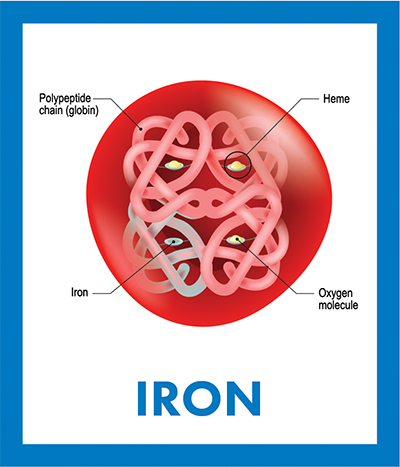For February, it’s iron — atomic No. 26
Hemoglobin is a tetramer that consists of four polypeptide chains. Each monomer contains a heme group in which an iron ion is bound to oxygen. In iron-deficiency anemia, the heart works harder to pump more oxygen through the body, which often leads to heart failure or disease.We are celebrating the 150th anniversary of Mendeleev’s periodic table by highlighting one or more chemical elements with important biological functions each month in 2019. For January, we featured atomic No. 1 and dissected hydrogen’s role in oxidation-reduction reactions and electrochemical gradients as driving energy force for cellular growth and activity.

In February, we have selected iron, the most abundant element on Earth, with chemical symbol Fe (from the Latin word “ferrum”) and atomic number 26.
A neutral iron atom contains 26 protons and 30 neutrons plus 26 electrons in four different shells around the nucleus. As with other transition metals, a variable number of electrons from iron’s two outermost shells are available to combine with other elements. Commonly, iron uses two (oxidation state +2) or three (oxidation state +3) of its available electrons to form compounds, although iron oxidation states ranging from -2 to +7 are present in nature.
Iron occurs naturally in the known universe. It is produced abundantly in the core of massive stars by the fusion of chromium and helium at extremely high temperatures. Each of these supergiant, iron-containing stars only lives for a brief while before violently blasting as a , scattering iron into space and onto rocky planets like Earth. Iron is present in the Earth’s crust, core and mantle, where it makes up about 35 percent of the planet’s total mass.
Iron is of all living organisms. Biological systems are exposed constantly to high concentrations of iron in igneous and sedimentary rocks. Microorganisms can uptake iron from the environment by secreting iron-chelating molecules called siderophores or via membrane-bound proteins that reduce Fe+3 (ferric iron) to a more soluble Fe+2 (ferrous iron) for intracellular transport. Plants also use to acquire iron from the rhizosphere, whereas animals obtain iron from dietary sources.
Once inside cells, iron associates with carrier proteins and with iron-dependent enzymes. Carrier proteins called ferritins (present in both prokaryotes and eukaryotes) store, transport and safely release iron in areas of need, preventing excess free radicals generated by high-energy iron. Iron-dependent enzymes include bacterial nitrogenases, which contain iron-sulfur clusters that catalyze the reduction of nitrogen (N2) to ammonia (NH3) in a process called nitrogen fixation. This process is essential to life on Earth, because it’s required for all forms of life for the biosynthesis of nucleotides and amino acids.
Some iron-binding proteins contain heme — a porphyrin ring coordinated with an iron ion. Heme proteins include cytochromes, catalase and hemoglobin. In cytochromes, iron acts as a single-electron shuttle facilitating oxidative phosphorylation and photosynthesis reactions for energy and nutrients. Catalase iron mediates the conversion of harmful hydrogen peroxide to oxygen and water, protecting cells from oxidative damage. In vertebrates, the Fe+2 in hemoglobin is reversibly oxidized to Fe+3, allowing the binding, storage and transport of oxygen throughout the body until it is required for energy production by metabolic oxidation of glucose.
Living organisms have adapted to the abundance and availability of iron, incorporating it into biomolecules to perform metal-facilitated functions essential for life in all ecosystems.
A year of (bio)chemical elements
Read the whole series:
For January, it’s atomic No. 1
For February, it’s iron — atomic No. 26
For March, it’s a renal three-fer: sodium, potassium and chlorine
For April, it’s copper — atomic No. 29
For May, it’s in your bones: calcium and phosphorus
For June and July, it’s atomic Nos. 6 and 7
Breathe deep — for August, it’s oxygen
Manganese seldom travels alone
For October, magnesium helps the leaves stay green
Enjoy reading ASBMB Today?
Become a member to receive the print edition four times a year and the digital edition monthly.
Learn moreGet the latest from ASBMB Today
Enter your email address, and we’ll send you a weekly email with recent articles, interviews and more.
Latest in Science
Science highlights or most popular articles

Bacteriophage protein could make queso fresco safer
Researchers characterized the structure and function of PlyP100, a bacteriophage protein that shows promise as a food-safe antimicrobial for preventing Listeria monocytogenes growth in fresh cheeses.

Building the blueprint to block HIV
Wesley Sundquist will present his work on the HIV capsid and revolutionary drug, Lenacapavir, at the ASBMB Annual Meeting, March 7–10, in Maryland.

Gut microbes hijack cancer pathway in high-fat diets
Researchers at the Feinstein Institutes for Medical Research found that a high-fat diet increases ammonia-producing bacteria in the gut microbiome of mice, which in turn disrupts TGF-β signaling and promotes colorectal cancer.

Mapping fentanyl’s cellular footprint
Using a new imaging method, researchers at State University of New York at Buffalo traced fentanyl’s effects inside brain immune cells, revealing how the drug alters lipid droplets, pointing to new paths for addiction diagnostics.

Designing life’s building blocks with AI
Tanja Kortemme, a professor at the University of California, San Francisco, will discuss her research using computational biology to engineer proteins at the 2026 ASBMB Annual Meeting.

Cholesterol as a novel biomarker for Fragile X syndrome
Researchers in Quebec identified lower levels of a brain cholesterol metabolite, 24-hydroxycholesterol, in patients with fragile X syndrome, a finding that could provide a simple blood-based biomarker for understanding and managing the condition.

